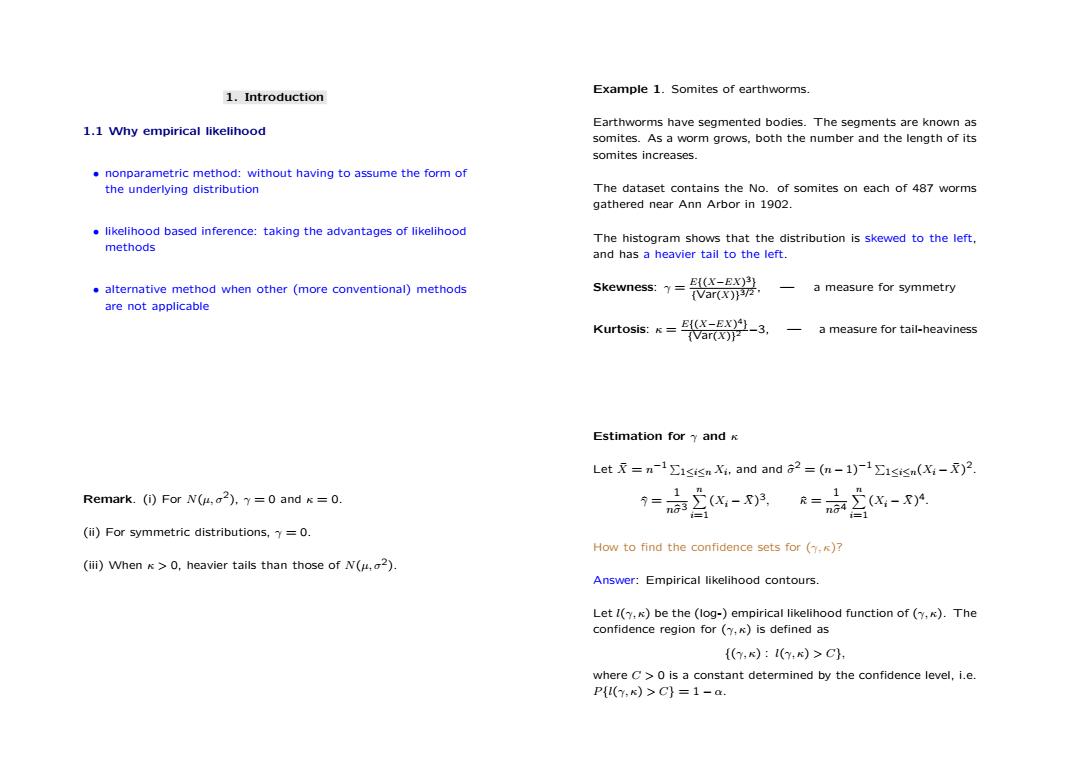正在加载图片...

Example 1.Somites of earthworms. 1.Introduction Earthworms have segmented bodies.The segments are known as 1.1 Why empirical likelihood somites.As a worm grows,both the number and the length of its somites increases. .nonparametric method:without having to assume the form of the underlying distribution The dataset contains the No.of somites on each of 487 worms gathered near Ann Arbor in 1902. likelihood based inference:taking the advantages of likelihood The histogram shows that the distribution is skewed to the left, methods and has a heavier tail to the left. E(X-EX)31 alternative method when other (more conventional)methods Skewness:=Var(X) a measure for symmetry are not applicable Kurtosis:=-3.a measure for tail-heaviness Estimation for y and K Let=n-1isisn Xi,and and 2=(n-1)-1 Eisisn(Xi-)2. Remark.(i)For N(u,o2),y=0 and K=0. 1" (K-)3, R=- (ii)For symmetric distributions,y=0. How to find the confidence sets for (y.) (iii)When >0,heavier tails than those of N(H,2). Answer:Empirical likelihood contours. Let l(y,K)be the (log-)empirical likelihood function of (y,K).The confidence region for (y,)is defined as {(Y,K):l(Y,K)>C, where C>0 is a constant determined by the confidence level,i.e. P{l(Y,K)>C}=1-a.1. Introduction 1.1 Why empirical likelihood • nonparametric method: without having to assume the form of the underlying distribution • likelihood based inference: taking the advantages of likelihood methods • alternative method when other (more conventional) methods are not applicable Example 1. Somites of earthworms. Earthworms have segmented bodies. The segments are known as somites. As a worm grows, both the number and the length of its somites increases. The dataset contains the No. of somites on each of 487 worms gathered near Ann Arbor in 1902. The histogram shows that the distribution is skewed to the left, and has a heavier tail to the left. Skewness: γ = E{(X−EX) 3} {Var(X)} 3/2 , — a measure for symmetry Kurtosis: κ = E{(X−EX) 4} {Var(X)} 2 −3, — a measure for tail-heaviness Remark. (i) For N(µ, σ2), γ = 0 and κ = 0. (ii) For symmetric distributions, γ = 0. (iii) When κ > 0, heavier tails than those of N(µ, σ2). Estimation for γ and κ Let X¯ = n −1 P 1≤i≤n Xi , and and σb 2 = (n − 1)−1 P 1≤i≤n(Xi − X¯) 2. γb = 1 nσb3 Xn i=1 (Xi − X¯) 3 , κb = 1 nσb4 Xn i=1 (Xi − X¯) 4 . How to find the confidence sets for (γ, κ)? Answer: Empirical likelihood contours. Let l(γ, κ) be the (log-) empirical likelihood function of (γ, κ). The confidence region for (γ, κ) is defined as {(γ, κ) : l(γ, κ) > C}, where C > 0 is a constant determined by the confidence level, i.e. P{l(γ, κ) > C} = 1 − α